|

Introduction
There's been a few recent trend changes in the
desktop monitor market. Firstly the 27" size range has become increasingly
popular, almost becoming the entry point for many users now. This size sector
has now started to see some lower
resolution IPS models introduced. The ever-popular IPS panel technology
continues to be widely used, but has in some cases moved away from the
ultra-high resolution 2560 x 1440 27" panels and to a smaller 1920 x 1080
resolution instead. Secondly manufacturers are trying to keep retail costs of
their new screens down by using these lower resolution panels, but also
providing more basic and trimmed down features, often doing away with most of
the stand adjustments and connectivity options. Thirdly there seems to be a big
focus at the moment on "frameless" or "borderless" panels, with very thin bezels
and flat screen fronts.
AOC have adopted all of these changes with their
new i2757Fm / Fh models. The 27" screen makes use of LG.Display's new 1920 x
1080 resolution AH-IPS panel, in fact the first of this type that we have
tested. It also features an edge to edge "borderless" design and
is able to offer a very competitive retail cost thanks to some of its trimmed
down features. Having said that, the i2757Fm has actually been awarded an iF
Product Design Award 2012 and so it hasn't been completely cut back to become a
very basic model. You will note that the screen comes in two flavours -
the Fm and Fh models. As far as we can tell, both models are the same except
that the Fm model features an MHL interface which the Fh model does not.
Availability of each model may vary internationally as well, but the underlying
panel and other features appear to be the same. We have the i2757Fm with us for
review here.
AOC's website states:
"This Full HD monitor blows the contents of your Android devices up to an
impressive size: With the innovative MHL interface (Mobile High-Definition
Link) high-resolution photos, videos and games can be displayed directly
from a smartphone or tablet PC on the huge 68.6 cm (27″) screen. A practical
side effect: the mobile gadgets get charged at the same time. The LED model
utilises the high-quality IPS display technology, which, besides providing a
strong contrast und a brightness of 250 cd/m², stands for exceptionally good
colour fidelity and viewing angle stability. A big stage for your photos and
videos!"

Specifications and Features
The following table gives detailed information
about the specs of the screen:
|
Monitor
Specifications |
|
Size |
27"WS (68.6cm) |
Panel Coating |
Light AG Coating |
|
Aspect Ratio |
16:9 |
Interfaces |
HDMI x2 (HDCP) with MHL support, D-sub VGA |
|
Resolution |
1920 x 1080 |
|
Pixel Pitch |
0.311 mm |
Design
colour |
Glossy black bezel sides/top, silver aluminium
style plastic
bottom edge and base |
|
Response Time |
5ms G2G |
Ergonomics |
-5° to 15°
Tilt adjustment only |
|
Static Contrast Ratio |
1000:1 |
|
Dynamic Contrast Ratio |
20
million:1 |
VESA Compatible |
No |
|
Brightness |
250 |
Accessories |
Power cord and block, D-sub cable, HDMI cable,
audio cable |
|
Viewing Angles |
178/178 |
|
Panel Technology |
AH-IPS |
Weight |
With stand: 5.7Kg |
|
Backlight Technology |
W-LED |
Physical Dimensions
|
WxHxD with stand
622 x 449 x 130 mm |
|
Colour Depth |
16.7m (6-bit + AFRC) |
|
Colour Gamut |
Standard gamut, sRGB
~72% NTSC |
Special
Features |
Audio in connection, headphone socket, integrated speakers, MHL support (Fm model only) |
Manufacturers website link:
AOC Europe (i2757Fm mode)
The feature set of the i2757Fm is somewhat limited. There are only 1x D-sub
(VGA) and 2x HDMI connections available for video connectivity. There is no DVI
and so you will need a DVI > HDMI cable or adapter if you want to connect from a
DVI port on your graphics card. It might have been preferable to feature 1x HDMI
and 1x DVI as opposed to having two HDMI ports here. There is also no DisplayPort connection which is
becoming increasingly popular nowadays. There is an audio out connection on the
back of the screen if you want to listen to the sound sent over HDMI (if using
HDMI end to end), but there are no integrated speaker on this model. The
HDMI interfaces support HDCP for encrypted content. MHL is also supported over
one of the HDMI connections (port 1). This is a new connectivity option which is starting
to appear on a few monitors. It allows you to connect an MHL-supporting mobile
or tablet device to the screen and view videos and photos saved on the device
via your screen. It also charges the device while connected which is useful.
The screen comes packaged with a D-sub VGA
cable and an HDMI cable which is nice to see. The screen features an external
power supply brick which comes packaged as well. There are no extra features
here like USB ports or card readers, which are featured on some other models.
There is however integrated speakers if you want to use them which might be
useful to some users.
Below is a summary of the features and connections of
the screen:
|
Feature |
Yes / No |
Feature |
Yes / No |
|
Tilt adjust |
 |
DVI |
 |
|
Height adjust |
 |
HDMI |
 |
|
Swivel adjust |
 |
D-sub |
 |
|
Rotate adjust |
 |
DisplayPort |
 |
|
VESA compliant |
 |
Component |
 |
|
USB Ports |
 |
Composite |
 |
|
Card Reader |
 |
Audio connection |
 |
|
Ambient Light Sensor |
 |
HDCP Support |
 |
|
Touch Screen |
 |
MHL support |
 |
|
Hardware calibration |
 |
Integrated Speakers |
 |
|
Uniformity correction |
 |
PiP / PbP |
 |

Design and Ergonomics
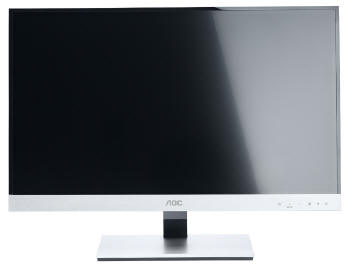
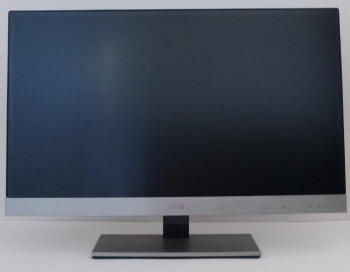
Above:
front views of the screen. Click for larger versions
The i2757 comes in a
primarily silver brushed aluminium style design. This is actually plastics
designed to look like brushed aluminium incidentally but looks attractive. There is a thick lower edge to
the screen which measures about 33mm thickness. This has the OSD control
buttons situated on the front in the lower right hand corner, and a shiny
silver AOC logo in the middle. It also houses the screens integrated
speakers.
Around the other edges of the screen is a
very thin black plastic trim which is only ~2.5mm thick. This is the
normal outer bezel of the screen but it should be noted that the image of
the panel does not go all the way to the edge of the screen. There is also
an "inner bezel" which is about 9.5mm thick before the actual image of the
screen is shown. This is like a black border around the edge of the image
and so gives the flat front and "borderless" design we spoke about
earlier. Overall there is a gap of ~12mm from the edge of the image to the
edge of the screen if you are thinking about multi-monitor setups.

The image above shows the
outer and inner bezels of the screen to help explain this further.
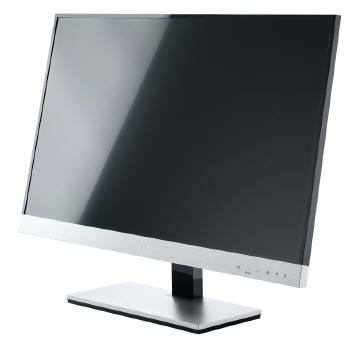
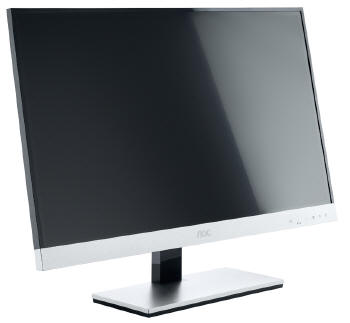
Above:
more front views of the screen. Click for larger versions
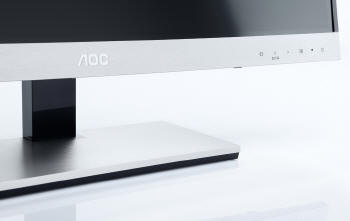
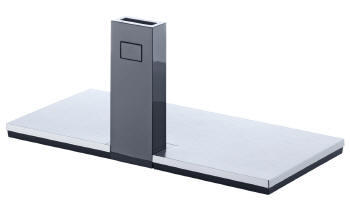
Above:
views of the stand and base. Click for larger versions
The screen has a fairly large rectangular
shaped base as shown above. This is finished in the same silver brushed
aluminium style plastic design as the lower edge of the screen. This gives the screen a
large footprint measuring 300 x 130mm but provides a pretty sturdy base
for the large 27" screen. The arm at the back of the base is finished in a
glossy black plastic. There is no cable tidy clip provided on this model,
although the screen does sit low on the desk, meaning cables can be hard
to see anyway depending on the users height.
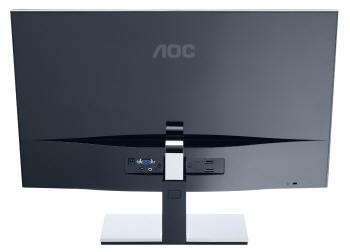
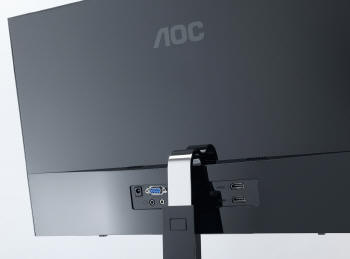
Above:
rear views of the screen. Click for larger versions.
The back of the screen is finished in glossy
black plastic as well, providing a smooth surface and finish. There is an
AOC logo near the top as shown. At the bottom is a section where the
interface connections are located. These stick directly out from the back
of the screen as opposed to being positioned vertically as they are on
most screens.

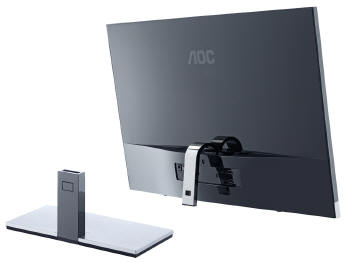
Above:
rear views showing connection of the monitor into the base. Click for
larger versions
Just above the interface connections there
is a silver coloured metal arm which comes out of the back of the screen
in a curved shape. This slots into the arm of the base as shown above and
clips into place.
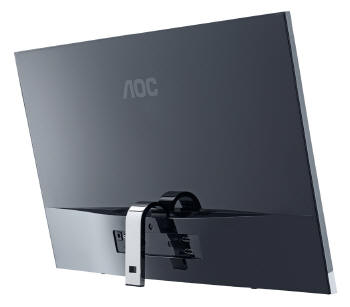
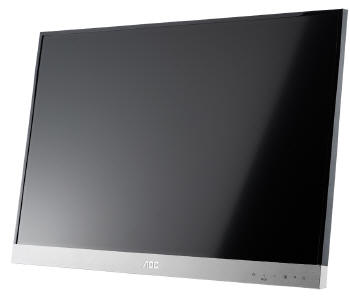
Above:
views of the screen without the base connected. Click for larger versions
If you want to however you can also use the
screen without the base as shown above. The curved metal arm acts as the
support for the screen, but this of course would mean the monitor sits even lower on the
desk, flat in fact. There are a couple of rubber feet on the bottom edge
of the screen to keep it stable if you opt to not use the stand. The screen is not VESA compatible and so cannot be wall mounted
unfortunately.
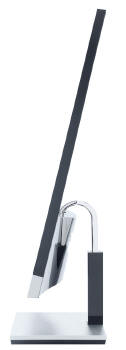
Above:
side profile view. Click for larger version
The screen has a nice thin side profile as
shown above thanks to the use of W-LED backlighting and an external power
supply. Overall the screen looks thin and sleek and the flat front and
silver aluminium style plastic trim gives it a quality feel.

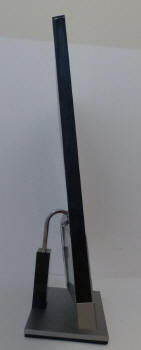
Above:
side views showing full tilt adjustment range. Click for larger versions
The screen offers only a basic tilt
adjustment from the stand. This is easy enough to position and offers
smooth movements. However, the range is somewhat limited, especially when
trying to tilt the screen backwards. There is no height, swivel or rotate
adjustments offered from the stand unfortunately which were left off to
help keep costs down.
A summary of the screens ergonomic adjustments
is shown below:
|
Function |
Range |
Smoothness |
Ease of Use |
|
Tilt |
-5° to +15° |
Smooth |
Easy |
|
Height |
n/a |
|
|
|
Swivel |
n/a |
|
|
|
Rotate |
n/a |
|
|
|
Overall |
Only tilt available but easy to use and
smooth movements. Limited adjustment range however |
The materials seemed of a reasonably high quality although the panel and
screen was a little flimsy in places, particularly in the bottom corners where
it didn't seem to fit quite right. There was no audible noise from the screen
and it stayed cool during use thanks to the W-LED backlighting unit. The power
supply brick got a little warm but not overly hot.

Above:
back view showing interface connections. Click for larger version
The back of the screen features the interface
connections as shown above. There is a connection on the far left for the
power supply, a D-sub VGA port and two audio connections. One is an audio
input so you can connect from your PC into the screen and use the integrated
speakers if you wish. The other is a headphone socket for if you want
individual use. On the right are the two HDMI connections, with HDMI 1 being
able to support MHL as well.

OSD Menu

Above: view of OSD operational buttons. Click for larger version
The OSD is controlled via 4 touch sensitive
buttons located on the lower right hand edge of the bezel. There is also a touch
sensitive power on/off button to the right of these, along with a small square
LED. This glows blur during normal operation and amber in standby. The buttons
work pretty well and responsive to the touch.

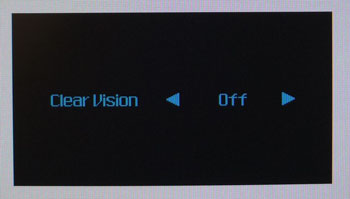 
There is quick access to the input
selection from the left hand button, the ClearVision control (left arrow) and
volume control (right arrow). Pressing the button on the right hand end brings
up the main OSD menu.

The menu itself is presented as shown above, with a long bar across the bottom
of the screen. The menu is split into 7 sections along the top grey bar, and you
can navigate between them using the left/right arrows. The menu software is a
little sluggish and slow but works well enough.
The first section is the 'luminance' menu. Here
you can control the contrast and brightness setting of the screen. There is also
access to the ECO
mode preset menu, gamma control,
dynamic
contrast ratio and
overdrive setting.
We will test these settings later on in the review.
The second section is the 'image setup' menu but
it is greyed out here since we are using digital HDMI connectivity, and the
settings are only applicable when using analogue D-sub.

The third section is the 'color setup' menu with options to control the color
temp, DCB mode and RGB levels if
available.

The fourth section is the 'picture boost' menu. You can activate AOC's 'Bright
Frame' feature here which gives you an adjustable "frame" you can move around
the screen where brightness and contrast can be controlled separately. This
might be useful if watching a video or something on only a small part of the
screen where you want to boost the brightness for example, leaving the rest of
the screen as normal.

The fifth section allows you to control the OSD menu settings.

The sixth section is the 'extra' menu where you can control the video input and
off timer if you want. After that, the 7th "section" is the exit option,
allowing to to leave the OSD if you want.
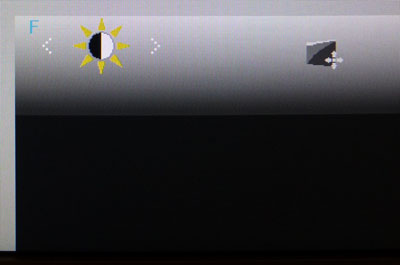
There is also a hidden factory OSD menu available on this screen. You can access
this by holding both the right and left arrow buttons down while you power the
screen on. Once on, if you go into the OSD menu you will see a small "F" in the
top left hand corner which is now an additional selectable section. Use this
section at your own risk!
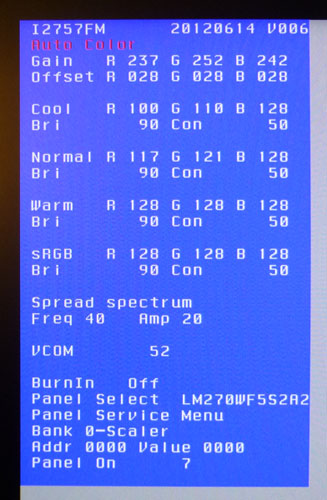
Accessing the factory menu confirms a few aspects
related to the preset mode settings. The panel being used in the display is also
confirmed at the bottom which is useful to know.
All in all the OSD offered a good range of options
and adjustments. The software was pretty slow though and looked a bit chunky.
Navigation wasn't too bad but not as intuitive as we've seen on some other
screens. The touch sensitive buttons were a nice feature though and gave the
screen a more premium feel.

Power Consumption
In terms of power consumption the manufacturers spec states
power usage of <29W when the screen is turned on, presumably meaning at any
brightness setting. In standby the screen is specified to
use <0.5W, and when turned off it uses <0.3W.
|
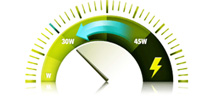 |
|
State and Brightness
Setting |
Manufacturer Spec (W) |
Measured Power Usage
(W) |
|
Factory Default (90%) |
- |
29.5 |
|
Calibrated (41%) |
- |
20.9 |
|
Maximum Brightness (100%) |
<29W |
31.6 |
|
Minimum Brightness (0%) |
- |
13.3 |
|
Standby |
<0.5W |
0.5 |
|
Off |
<0.3W |
0.6 |
|
We tested this ourselves and found that out of the
box the screen used 29.5W of power while at its default brightness setting which
was 90%. At the lowest brightness setting, power consumption was reduced to
13.3W and at maximum 100% brightness it reached 31.6W, a little higher than the
spec suggested it would. After calibration the
brightness setting had been adjusted to 41%
and the power consumption was measured at 20.9W. In standby the screen used
0.5W of power and oddly when switched off it used slightly more at 0.6W. We have plotted these measurements on the graph below for
comparison with other screens:
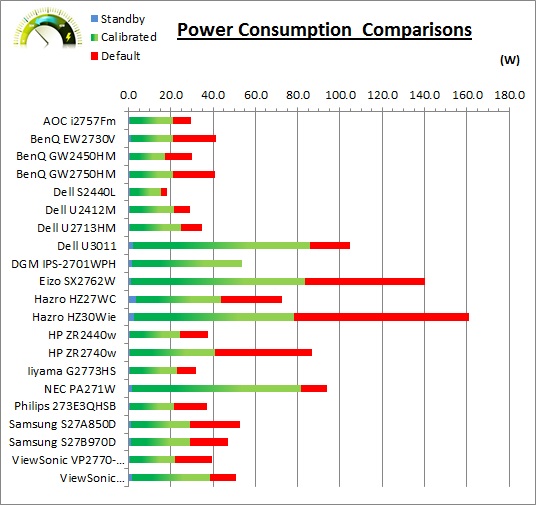

Within the 'luminance' section of the OSD menu is an
option for the 'ECO mode' setting as shown above, designed to give you quick
control to preset maximum brightness settings through a series of defined usage
modes. Unlike preset modes on other screens these modes do not seem to change
the colours or other aspects of the image, they simply lock the brightness
setting at a defined level. We tested the power consumption at each below:
|
ECO Mode Setting |
Capped Brightness
Setting |
Power Usage
(W) |
|
Standard |
Not locked |
Variable |
|
Text |
20 |
16.8 |
|
Internet |
40 |
20.0 |
|
Game |
60 |
24.3 |
|
Movie |
80 |
27.6 |
|
Sports |
100 |
31.6 |

Panel and Backlighting
|
Panel Manufacturer |
LG.Display |
Colour Palette |
16.7 million |
|
Panel Technology |
AH-IPS |
Colour Depth |
6-bit + AFRC |
|
Panel Module |
LM270WF5-S2A2 |
Colour space |
Standard gamut, ~sRGB |
|
Backlighting Type |
W-LED |
Colour space coverage (%) |
~72% NTSC |
Panel and Colour Depth
The AOC i2757Fm utilises an
LG.Display LM270WF5-S2A2 AH-IPS panel which is capable of producing 16.7
million colours. This is achieved through the use of a 6-bit panel with
Advanced Frame Rate Control (AFRC). This is the latest generation of
so-called AH-IPS panel from LG.Display although in reality it is unclear what
really makes these AH-IPS generation panels any different to the older H-IPS
(and e-IPS) variants. So far we have seen these new generation panels used in
the
Dell U2713HM and
NEC P232W and have been pleased to find that the AG coating has been
noticeably reduced. Perhaps this is one of the key changes with the AH-IPS
generation. The panel is confirmed when accessing the factory OSD menu as shown
below.

Above: Factory
OSD menu
Panel Coating
The
screen coating on the i2757Fm is a normal anti-glare (AG) offering. Readers
will be pleased to hear though that the AG coating is actually nice and light
and is not the usual grainy and aggressive solution you would normally find on
an IPS panel or on the older models. It is very comparable to what we saw on the
recently released
Dell U2713HM, perhaps slightly more grainy but not by much. LG.Display seem to have toned down the AG coating which is
great news. It retains its anti-glare properties to avoid unwanted reflections,
but does not produce an overly grainy or dirty image that some AG coatings can.
Backlighting and Colour Gamut
The i2757Fm uses
White-LED (W-LED) backlighting producing a colour space approximately equal
to the sRGB reference. This means the screen is considered a 'standard gamut'
backlight type. The gamut would cover approximately 72% of the NTSC reference
space. A wide gamut screen would need to be considered by those wanting to work
outside of the sRGB colour space of course.
PWM Flicker Tests at Various
Backlight Brightness Settings
100%
50%
0%

|
Pulse Width
Modulation Used |
Yes |
|
Cycling
Frequency |
~236 Hz |
|
Possible
Flicker at |
|
|
100% Brightness |
No |
|
50% Brightness |
Yes |
|
10% Brightness |
Yes |
We tested the screen to establish the methods used
to control backlight dimming. Our recent article talks in more details about a
common method used for this which is called
Pulse Width Modulation (PWM). A series of photos was taken using the method
outlined in the article. These were taken at 100%, 50% and 0% brightness
settings. These tests
allow us to establish 1) whether PWM is being used to control the backlight, 2)
the approximate frequency at which this operates, and 3) whether a flicker may be introduced
or potentially noticeable at certain settings.
A thin white line was shown on an all-black
background and a photograph was taken at a slow shutter speed of 1/8 second (in
this example) as
the camera was scanned left to right in front of the screen. This produces a
series of white lines which can be used to identify the frequency of the PWM and
how quickly the backlight is cycled on and off. The higher this frequency, the
less likely you are to see artefacts and flicker. The duty cycle (the time for
which the backlight is on) is also important and the shorter the duty cycle, the
more potential there is that you may see flicker. Please remember that not every
user would notice a flicker from the backlight but it is something to be wary
of. It is also a hard thing to quantify as it is very subjective when talking
about whether a user may or may not experience the side effects. We are able to
at least measure the frequency of the backlight using this method and tell you
whether the duty cycle is sufficiently short at certain settings that it may
introduce a flicker to those sensitive to it.
The AOC i2757Fm showed a cycling frequency of
~240Hz (30 lines at 1/8 second shutter speed) in the initial tests shown here. A
further test at an even slower shutter speed confirmed the cycling frequency at
approximately 236Hz. At 100% brightness there should be no flicker evident as
the backlight is not cycled on and off using PWM. At lower settings PWM is used
and the duty cycle becomes progressively shorter. Given the relatively low
frequency of the PWM cycling compared with some other displays (e.g. PWM of
350Hz+) and the use of LED backlighting, there is a chance that flicker may be
evident to some users as you lower the brightness setting as a result. Some
screens we have tested recently (e.g. DGM IPS-27001WPH, Samsung S27B970D,
ViewSonic VP2770-LED and Dell U2713HM) have not used PWM at all, but it it still
a long-established technique and obviously still being used widely in the
market.

Testing
Methodology
An
important thing to consider for most users is how a screen will perform out of
the box and with some basic manual adjustments. Since most users won't have
access to hardware colorimeter tools, it is important to understand how the
screen is going to perform in terms of colour accuracy for the average user.
I
restored my graphics card to default settings and disabled any previously active
ICC profiles and gamma corrections. The screen was tested at default factory settings using the DVI interface, and analysed using
an
X-rite i1
Pro Spectrophotometer (not to be confused with the new i1 Display Pro
colorimeter) combined with
LaCie's Blue Eye Pro software suite. An NEC branded and customised X-rite i1 Display 2 colorimeter was
also used to verify the black point and contrast ratio since the i1 Pro is less
reliable at the darker end.
Targets for these tests are as follows:
-
CIE Diagram - validates the colour space
covered by the monitors backlighting in a 2D view, with the black triangle representing the
displays gamut, and other reference colour spaces shown for comparison
-
Gamma - we aim for 2.2 which is the default
for computer monitors
-
Colour temperature / white point - we aim
for 6500k which is the temperature of daylight
-
Luminance - we aim for 120
cd/m2, which is
the recommended luminance for LCD monitors in normal lighting conditions
-
Black depth - we aim
for as low as possible to maximise shadow detail and to offer us the best
contrast ratio
-
Contrast ratio - we aim
for as high as possible. Any dynamic contrast ratio controls are turned off here
if present
-
dE average / maximum -
as low as possible.
If DeltaE >3, the color displayed is significantly different from the
theoretical one, meaning that the difference will be perceptible to the
viewer.
If DeltaE <2, LaCie considers the calibration a success; there remains a
slight difference, but it is barely undetectable.
If DeltaE < 1, the color fidelity is excellent.

Default Performance and
Setup
IMPORTANT NOTE: Before we get into this
section we need to make an important note about use of the HDMI port. The
screen only features a single D-sub VGA and 2x HDMI port. Naturally you will
probably want to use the digital HDMI connection if you can for optimum
picture quality. If you have an NVIDIA graphics card and want to use the HDMI
at all, whether a straight HDMI > HDMI connection or a DVI > HDMI conversion,
you need to make a change to your graphics card settings to display the
optimum picture. This is because by default the output range over HDMI is
limited by the graphics card, and it can greatly limit the picture quality and
in particular the black range and contrast ratio.
A change is needed via your graphics card to
ensure a full 0 - 255 output when using HDMI, rather than it being limited to
a smaller output range of 16 - 235. This applies to NVIDIA cards but is only
necessary when connecting to the HDMI port on the screen and is not needed
when using D-sub. A similar change might be required when using an AMD
graphics card but the setting is built into their graphics card drivers we
believe. For NVIDIA cards the simplest way to ensure a full output range is to
use the handy toggle utility
available here.
If you run the program you can select a full 0- 255 range quickly and easily.
Default settings of the screen were as follows:
|
Monitor OSD Option |
Default Settings |
|
Brightness |
90 |
|
Contrast |
50 |
|
ECO mode |
Standard |
|
Gamma |
Gamma1 |
|
Color Temp |
Warm |
|
RGB |
50, 50, 50 (locked) |

AOC i2757Fm - Default Factory Settings



|
|
Default Settings |
|
luminance (cd/m2) |
224 |
|
Black Point (cd/m2) |
0.20 |
|
Contrast Ratio |
1094:1 |
The default set of the screen felt ok to the naked
eye, perhaps a little cool, and as is normal for most screens it was too bright
for comfortable prolonged use. The screen comes out of the box with a 90% brightness
setting that will need to be turned down a fair amount certainly. In terms of measurements, the
CIE diagram on the left confirms that the monitors colour gamut (black
triangle) matches the sRGB colour space (orange triangle) very closely. It
extends a little past the sRGB space in some shades in blues and greens, but falls a
little short in some reds in this 2D view of gamut. For all intents and purposes
this is a standard gamut sRGB colour space screen.

Default gamma was measured at 2.2 average, leaving
it only 2% out from the target of 2.2. This was too high in darker shades, and a
little low in lighter grey shades, as shown in the more detailed
table above. The white point was measured at 7007k, being 8% out from the target
of 6500k which wasn't too bad, but a bit cool. You will note that the screen
comes out of the box in the "warm" colour temperature mode which might seem a
bit odd as a default setup. Weirdly this "warm" mode was a little too cool and
in fact measuring some of the other modes revealed some other odd settings. In
the "warm" mode the RGB channels were all locked at 50. If you switch to the
sRGB color temp mode, nothing changes and the results are the same. The "user
mode" by default is also set at 50 each for RGB but you are able to change them
if you want. The "normal" mode is cooler still at 8171k (26% deviance from
6500k) but the "cool" mode behaves as it should, with a colour temperature of
11,398k measured. It seems that the normal mode is too cool, and the warm mode
is closer to the 6500k target, although still a little bit too cool. This
balance could have been better as it would have been nice to see a normal mode
nearer to 6500k and a warm mode which made it warmer still, going significantly
below 6500k. Different colour temperatures should be achievable through manual
adjustments in the user mode and with
calibration.
A summary of the default colour temperatures is provided below for reference.
|
Color Temp Mode |
RGB settings in OSD |
Measured Default Colour
Temperature |
|
Warm |
50, 50, 50 (locked) |
7007k |
|
Normal |
45, 47, 50 (locked) |
8171k |
|
Cool |
36, 41, 50 (locked |
11,398k |
|
sRGB |
50, 50, 50 (locked) |
7007k |
|
User |
50, 50, 50 (changeable) |
7007k |
Colour accuracy out of the box was pretty good
with an average dE of 2.7 and maximum of 4.9. Colour gradients showed smooth
transitions with some slight gradation at the darker end. No banding was
evident. Some slight flicker was evident from the FRC algorithm, but nothing
that a normal user should notice in practice. Luminance was too high as we had suspected, being measured at 224 cd/m2
by default while at the 90% brightness setting. We achieved a very high static
contrast ratio for an IPS panel of 1094:1 by default. Once
again, you do need to
change the colour
output range if you're using HDMI on an NVIDIA
card, otherwise contrast ratio will suffer massively.

Calibration Results
I wanted to calibrate and profile the screen to determine what was possible with optimum settings and
profiling. I used the
X-rite i1 Pro spectrophotometer
combined with the LaCie Blue Eye Pro software package to achieve these results
and reports. An NEC branded and customised X-rite i1 Display 2 was used to
validate the black depth and contrast ratios due to lower end limitations of the
i1 Pro device.

AOC i2757Fm - Calibrated Settings
|
Monitor OSD Option |
Calibrated
Settings |
|
Brightness |
41 |
|
Contrast |
50 |
|
ECO mode |
Standard |
|
Gamma |
Gamma1 |
|
Color Temp |
User |
|
RGB |
49, 49, 48 |
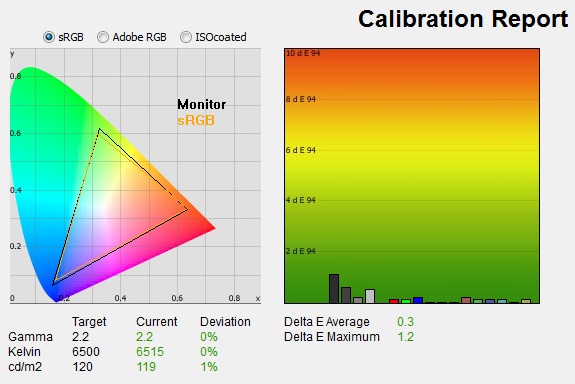
|
|
Calibrated Settings |
|
luminance (cd/m2) |
119 |
|
Black Point (cd/m2) |
0.12 |
|
Contrast Ratio |
964:1 |
I reverted to the 'user' color temp mode in the OSD menu which would allow me access to the individual RGB channels.
Adjustments were also made during the process to the brightness control, and to
the RGB channels as shown in the table above. This allowed me to obtain an
optimum hardware starting point and setup before software level changes would be
made at the graphics card level which would help preserve tonal values. After this I let the software carry out the LUT adjustments and create an
ICC profile. The screen does not feature a hardware LUT calibration option
so other than the OSD alterations, the rest of the process is carried out at a
graphics card level in profiling the screen.

Average gamma had been corrected to 2.2 with 0%
deviance overall according to the initial test, correcting the default 2% deviance we'd
found in this preset. The 8% deviance in the white point from our target
of 6500k had also been corrected here and the colour temperature was now pretty
much spot on at 6515k. Luminance had also been corrected thanks to the
adjustment to the brightness control, now being measured at 119
cd/m2. This
also gave us a calibrated black depth of 0.12 cd/m2, and an excellent
(for an IPS panel) calibrated
static contrast ratio of 964:1. Colour
accuracy had also been corrected nicely, with dE average of 0.3 and maximum of
1.2. LaCie would consider colour fidelity to be excellent now overall.
Testing the screen with various colour gradients
showed mostly very smooth transitions. There was some slight gradation in darker
tones and some very slight banding evident due to the profile adjustments made
here. Nothing too major though that would be noticeable in most normal uses. It's worth also
commenting on the screen coating in this section of the review. Unlike many
other IPS panels, this screen does not feature the usual heavy and aggressive
Anti-glare (AG) coating which can sometimes lead to grainy and dirty looking
images. Instead it uses a light AG screen coating and as a result the colours
look more clean and crisp, the image quality is sharp and whites in particular
look more pure than they do on heavy AG coated screens. It isn't a full glossy
solution which adds another level of clarity and changes the overall feel
of the screen, but it is an improvement over the heavy AG coating of some other
IPS screens.
You can use our settings and
try our calibrated ICC profile if you wish, which are available in
our ICC profile database. Keep in mind that results will vary from one
screen to another and from one computer / graphics card to another.

Calibration
Performance Comparisons
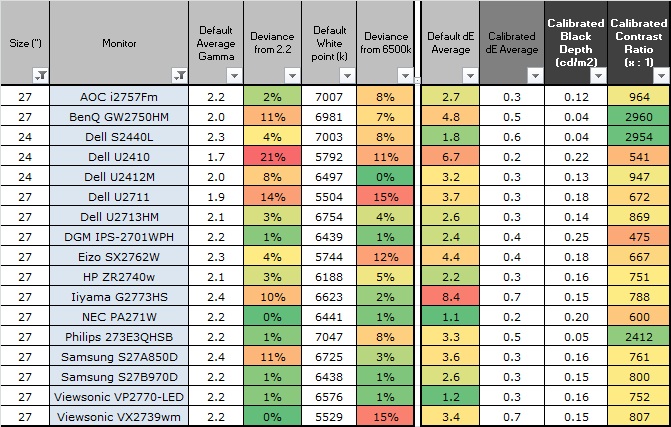
We've extended the comparisons made in this
section to try and give you a better view of how each screen performs,
particularly out of the box which is what is going to matter to most consumers.
When comparing the default factory settings for each monitor it is important to
take into account several measurement areas - gamma, white point and
colour accuracy. There's no point having a low dE colour accuracy figure if the
gamma curve is way off for instance. A good factory calibration requires all 3
to be well set up. We have deliberately not included luminance in this
comparison since this is normally far too high by default on every screen.
However, that is very easily controlled through the brightness setting (on most
screens) and should not impact the other areas being measured anyway. It is easy
enough to obtain a suitable luminance for your working conditions and individual
preferences, but a reliable factory setup in gamma, white point and colour
accuracy is important and not as easy to change accurately without a calibration tool.
From these comparisons we can also compare the
calibrated colour accuracy, black depth and contrast ratio. After a calibration
the gamma, white point and luminance should all be at their desired targets.
Default setup of the i2757Fm was pretty good on
the most part. Gamma was close to the target with only a 2% deviance. The white
point was a little further out being a little too cool with an 8% deviance, but
not a huge amount really. The default colour accuracy was pretty good as well at
2.7 dE average. A reasonable factory setup for this screen although a more
accurate white point would have been useful.

Default colour accuracy is compared again on the
above graph, with the i2757Fm having a pretty reliable default setup which is
nice to see.
Once calibrated the dE average was reduced to 0.3.
This would be classified as excellent colour fidelity by LaCie. It was not quite
as low as some of the other screens here which reached down to 0.2 average, but
in practice you would not notice any difference here at all. The professional
range models from NEC and Eizo are even more accurate than other
models shown here. Professional grade monitors like those offer other high end
features which separate them from some of these other models, including extended
internal processing, 3D LUT's and hardware calibration. These comparisons are
based on a small selection of tests, so it should be remembered that other
factors do come into play when you start talking about professional use.
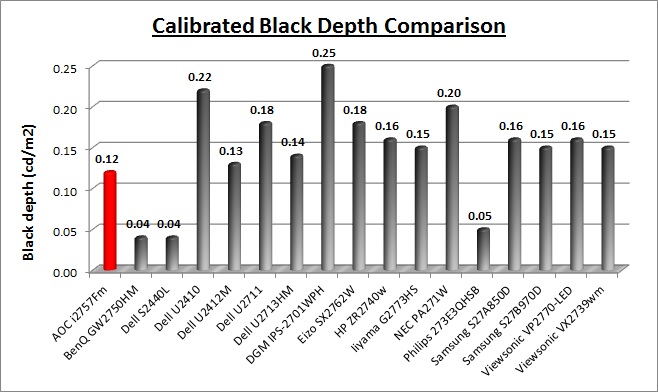
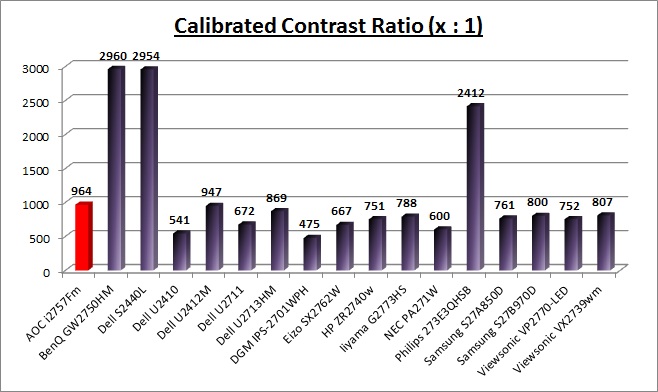
The calibrated black depth and contrast ratio of
the i2757Fm were excellent for an IPS panel, with a measured contrast ratio of
964:1. This was very pleasing for an IPS based screen although of course it
can't compete with the very high CR's of the VA based screens shown here. A
contrast ratio of ~1000:1 seems to be about the limit for IPS technology at the
moment.

Contrast
Stability and Brightness
I wanted to test a couple of things here. Firstly we wanted to establish the
adjustment range of the backlight through the use of the brightness control.
Secondly we wanted to see how much variance there was in the screens contrast
as we adjusted this brightness control.
In theory, brightness and contrast are two independent parameters, and good
contrast is a requirement regardless of the brightness adjustment.
Unfortunately, such is not always the case in practice. We recorded the
screens luminance and black depth at various OSD brightness settings, and
calculated the contrast ratio from there. Graphics card settings were left at
default with no ICC profile or calibration active. Tests were made using an
NEC branded and customised
X-rite i1 Display 2 colorimeter. It should be noted that we used the
BasICColor calibration software here to record these, and so luminance at
default settings may vary a little from the LaCie Blue Eye Pro report.
|
OSD Brightness |
Luminance
(cd/m2) |
Black Point (cd/m2) |
Contrast Ratio
( x:1) |
|
100 |
249.63 |
0.23 |
1085 |
|
90 |
229.88 |
0.21 |
1095 |
|
80 |
210.03 |
0.19 |
1105 |
|
70 |
190.99 |
0.17 |
1123 |
|
60 |
172.04 |
0.16 |
1075 |
|
50 |
152.97 |
0.14 |
1093 |
|
40 |
133.46 |
0.12 |
1112 |
|
30 |
114.00 |
0.10 |
1140 |
|
20 |
94.56 |
0.08 |
1182 |
|
10 |
74.75 |
0.07 |
1068 |
|
0 |
54.75 |
0.05 |
1095 |
|
Total Luminance Adjustment Range = 194.88 cd/m2
Total Black
Point Adjustment Range = 0.18 cd/m2
Average
Contrast Ratio = 1107:1
Recommended OSD setting for 120 cd/m2 = 33%
|
The luminance range of the screen was good. At the
top end the panel reached 249.63
cd/m2 which was basically spot on with
the specified maximum of 250 cd/m2. At the lower adjustment end it could
reach down to a low 54.75 cd/m2 meaning the screen should be
fine even in darkened room conditions for most users. It doesn't quite offer the
lower adjustment range of some screens but it's still more than adequate. A brightness setting of ~33% should return you a
default luminance of around 120 cd/m2 as well. Black point remained
low across the adjustment range, from 0.23 cd/m2 down to 0.05 cd/m2.

We have plotted the
luminance trend on the graph above. The screen behaves as it should, with a
reduction in the backlight intensity controlled by the reduction in the OSD
brightness setting. This was a linear relationship overall.

Average default contrast ratio
measured was ~1107:1 which was excellent for an IPS panel. This seemed to
fluctuate a little across the brightness adjustment range but not by anything
significant.

Dynamic Contrast
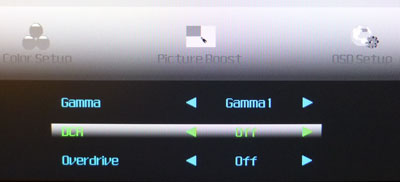
The AOC i2757Fm features a dynamic contrast ratio
(DCR) control, which boasts a spec of 20,000,000:1 (20 million:1). Dynamic
contrast ratio involves controlling the backlight of the screen automatically,
depending on the content shown on the screen. In bright images, the backlight
is increased, and in darker images, it is decreased. We have come to learn
that DCR figures are greatly exaggerated and what is useable in reality is
often very different to what is written on paper or on a manufacturers
website.
For this test I would use the colorimeter to record the
luminance and black depths at the two extremes. Max brightness would be
recorded on an almost all white screen. Black depth would
be recorded on an almost all black screen. In real use you are very
unlikely to ever see a full black or full white screen, and even our tests are
an extreme case to be honest. Carrying out the tests in this way does give you
a good indication of the screens dynamic contrast ratio in real life
situations however.
The DCR feature is available in all the ECO
modes and has a simple setting for on or off. Once enabled you cannot control the
brightness setting manually and it becomes greyed out.
|
|
Dynamic Contrast |
|
Specified DCR Range |
20 million: 1 |
|
Available in Presets |
All ECO modes |
|
Settings |
On / Off |
|
Max luminance (cd/m2) |
245.14 |
|
Min Black Point (cd/m2) |
0.12 |
|
Max Dynamic Contrast Ratio |
2043:1 |
We tested the DCR feature and you could
immediately notice the screen getting much brighter when you first turn it on
compared with the standard
calibrated
state. When switching between an almost all-white and an almost all-black screen there
was a subtle change in the brightness of the screen which you could detect with
the naked eye. It took about 3 seconds in total to change from one end to the
other. On an almost all-white screen we measured a luminance of 245
cd/m2 which was pretty much the maximum
possible from the panel when set at maximum brightness. On an almost all-black
screen the black depth reached down to 0.12 cd/m2. The DCR feature
seemed to be controlling the brightness level from ~100% down to ~40% in these
tests based on these measurements. This gave us a dynamic contrast ratio of
2043:1. Not massive, but at least somewhat usable, and able to double the
calibrated static contrast ratio we had achieved.
We tested the screen with a
completely black screen as well as on some screens that results in the backlight
being turned off completely. This is how manufacturers come up with their crazy
high DCR specs in the lab. It should be
noted that it would be extremely rare to ever see a 100% black image in real use
and so this is more of a theoretical DCR than a realistic, practical DCR.
You'd have to be turning
the backlight completely off on an all-black image to achieve anything near the
20 million:1 spec. In the case of the i2757Fm, this doesn't happen anyway.

Viewing Angles

Above: Viewing
angles shown from front and side, and from above and below. Click for
larger image
Viewing angles of the AOC i2757Fm are very good
and as you would probably expect from an IPS panel. Horizontally the fields of
view were very wide and a gamma shift was only really introduced from a wide
angle where the image darkened. Vertically the gamma shift was a little more
pronounced but overall the fields of view were very good. The panel was free
from the off-centre contrast shift you would see from VA matrices and this is
one of the reasons why IPS is so widely regarded as the panel technology of
choice for colour critical displays. The panel of course offered far wider
viewing angles than TN Film matrices which can be very restrictive, especially
vertically.
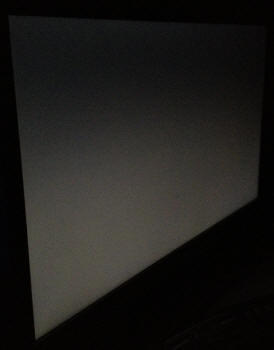
Above: View of an all black screen from the side. Click for larger version
On a black image, like many other IPS panels,
there is a white glow when viewed from an angle. This picture was taken in a
darkened room though and in normal working conditions this shouldn't present
much problem. In fact the white glow was much less pronounced than on some other
IPS panels we have tested and was not too bad at all. Given the large 27" screen
size there is still some "IPS glow" noticeable from the corners as you look at
the screen head on from a relatively close distance.

Panel Uniformity
We wanted to test here how uniform the brightness
was across the screen as well as identify any leakage from the backlight in
dark lighting conditions. First of all measurements of the luminance were taken
at 35 points across the panel on a pure white background. The measurements were
taken using BasICColor's calibration software package, combined with the NEC
customised X-rite
i1 Display 2 colorimeter. The below uniformity diagram shows the difference, as
a percentage, between the luminance recorded at each point on the screen, as
compared with the reference point of a calibrated 120 cd/m2. This is
the desired level of luminance for an LCD screen in normal lighting conditions,
and the below shows the variance in the luminance across the screen
compared with this point. It is worth noting that panel uniformity can vary from
one screen to another, and can depend on manufacturing lines, screen transport
and other local factors. This is only a guide of the uniformity of the sample
screen we have for review.
Uniformity of Luminance

The overall uniformity was mediocre here. The
central region of the screen remained close to the target luminance of 120
cd/m2 but it did seem to drop a fair
amount in the upper corners of the screen. In the top left the luminance
dropped down to 101 cd/m2 (-19% deviance) and in the top right it
dropped down to 103 cd/m2 (-16%). Overall approximately 2/3 of
the screen were within 5% deviance of the central point which was good.
Backlight Leakage

Above: All black screen in a darkened room. Click for larger version
As usual we also tested the screen with an all
black image and in a darkened room. A camera was used to capture the result.
There was no severe backlight leakage at all, and only some slight clouding
along the top right hand and bottom left hand edges. Nothing very noticeable at
all which was a good result.

General and Office Applications
The AOC i2757Fm isn't like many other 27" screens
in the market. It does not offer a massive WQHD 2560 x 1440 resolution and
instead sticks with a smaller 1920 x 1080 resolution across its 16:9 aspect
panel. While this of course has some cost saving advantages, and is perfectly
suitable for multimedia use, it is not as good for general day to day office
work. This relatively low resolution on such a large screen means there is a
0.311mm pixel pitch and the text appears large as a result. This might be good
for those with any kind of eye sight issues, and for those who prefer a larger
text size for a lot of web and text based work. However, you need to consider
that this same 1920 x 1080 resolution can be found on small screens as well,
including 21.5" diagonal models. On screens that size the resolution is arguably
a little too high and text is a little too small, but on a 27" diagonal sized
screen I personally think it is too low. The screen is certainly comfortable for
a lot of text reading, but it just doesn't look quite as sharp and crisp as a
higher resolution equivalent. You do also really miss the desktop real-estate
when coming from a 2560 x 1440 screen to this.
The resolution is still adequate for side by side
splitting of content on the screen which is useful. The digital HDMI interface
offered a slightly sharper image quality than the D-sub analogue interface and
so should be used wherever possible for your PC connection. Remember to make the
adjustment to
your graphics card output range if you're using HDMI from an NVIDIA card. At
least with the AG coating being light here the white backgrounds did not appear
too grainy or dirty as they can on some other IPS panels with heavy AG coating.
Default luminance of the screen was recorded at 224
cd/m2
which is too high for prolonged office use. You will want to turn the screen
down probably to around 33% brightness to achieve a luminance of around 120 cd/m2.
Those wanting to use the screen in darker room conditions and at a luminance
lower than this can do so through further adjustment to this setting, down to
around 55 cd/m2 minimum which should be adequate for most cases.
There is a
specific 'text' and 'internet' preset mode available from the
ECO mode in
the OSD which will cap the brightness setting at a defined level. Maybe useful
to some users, perhaps in an office environment or something, but for most users
a manual control over the brightness setting in the 'standard' ECO mode is
probably preferred. The default setup of the screen was pretty good as well with
a good gamma setup and colour accuracy. The white point was a little too cool
sadly, but if you follow our basic OSD adjustments from our
calibration
process (and maybe also try our calibrated ICC profile) you should be able
to get an even better setup, even without a colorimeter of your own. The
ClearVision feature seems to accentuate the sharpness of the image and there are
settings for weak, medium and strong. Some users may wish to experiment with
these, but personally I prefer the more natural sharpness with the setting off.
They are probably more useful for movies and games where sometimes the
exaggerated sharpness can look nice.
The screen sadly does not offer any USB ports
which I think are always handy for connecting external devices. There are also
very limited ergonomic adjustments available from the stand with only a tilt
function provided. This adjustment is also a little limited in range back and
forth unfortunately, and height adjustment is certainly missed. There are no
added functions such as ambient light sensors or human motion sensors here, but
AOC have included integrated speakers which should be ok for some casual 'office
noises' and the odd mp3 or YouTube video.

Responsiveness and Gaming
The i2757Fm is rated by AOC as having a 5ms G2G response time which implies the use of
overdrive /
response time compensation (RTC) technology. This is used to boost pixel
transitions across grey to grey changes and improve responsiveness in practice,
and reduce ghosting and blurring. The panel being used is an
LG.Display LM270WF5-S2A2 AH-IPS panel.

Before we get in to the side by side screen
comparisons I want to quickly talk about the
'overdrive' control available through the screens OSD menu as shown. It is
available within the 'luminance' section of the menu as shown above. This allows
you to manually control the level of overdrive / RTC impulse being applied to
the pixels, with options of off, weak, medium and strong being available. You
may wish to read our
specs section for some further information about overdrive / response time
compensation.
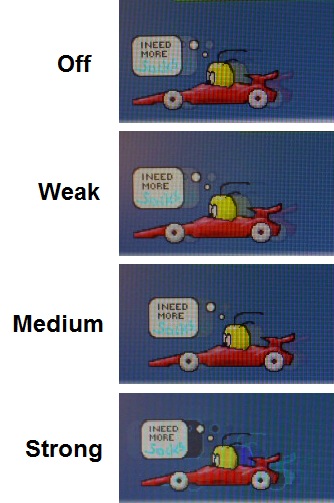
The screen was tested using the chase test in
PixPerAn, a good bit of software for trying to quantify differences in real
terms responsiveness between monitors. As a reminder, a series of pictures are
taken on the highest shutter speed and compared. The images above are the best
case examples from the screen with the 'overdrive' setting at each level. With
overdrive set to off, the image showed a reasonable amount of blur behind the
moving object. There was no severe ghosting or trailing as you might see on some
very slow panels, but the blur was pretty obvious. When switching to the 'weak'
overdrive level the moving car became ever so slightly sharper in practice and
blurring was reduced a very small amount. This level didn't seem to be changing
the response time much in practice.
When switching to the 'medium' setting there was a
more pronounced improvement. You could notice the reduction in the image blur by
a reasonable amount and the movement was sharper. This delivered a better pixel
response time and the overdrive was working well. The 'strong' option however
introduced a very noticeable and unwanted overshoot in the form of a dark and
pale trail behind the moving car. In this setting, the overdrive impulse was far
too aggressive and produced a lot of unwanted side effects. We would suggest
using the 'medium' setting for optimum pixel response times on this screen.
Display Comparisons
The screen was tested again using the chase test
in PixPerAn for the display comparisons. As a reminder, a series of pictures are
taken on the highest shutter speed and compared, with the best case example
shown on the left, and worst case example on the right. This should only be used
as a rough guide to comparative responsiveness but is handy for a direct
comparison of the impact of this setting:

27" 5ms G2G
LG.Display AH-IPS (overdrive = medium)
We have selected the medium overdrive setting here
for the comparisons since it had returned the optimum performance. In practice the
AOC i2757Fm delivered low levels of motion blur and a sharp moving image in this
setting. It was free of the very noticeable dark and pale overshoot artefacts
caused by the overly aggressive overdrive impulse in the 'strong' mode.

27" 5ms G2G
LG.Display AH-IPS (overdrive = medium)

27" 4ms G2G AU
Optronics AMVA (AMA = Premium)

27" 12ms G2G
LG.Display H-IPS

27" 8ms G2G
LG.Display AH-IPS
We have first of all provided a comparison against
3 other popular 27" models. In practice, the performance of the AOC's IPS panel
fairs very well. It is more responsive than the
BenQ GW2750HM which uses a modern AMVA panel. Historically AMVA panels have
been very slow, but this was one of the first of a new generation which showed a
marked improvement. It has slightly more motion blur than the AOC, and also
shows a slight dark overshoot which you can see in the image above, caused by a
poorly controlled overdrive impulse. The
HP ZR2740w is another 27" IPS panel, like the AOC, but is a 2560 x 1440
resolution model. It is free of any noticeable overshoot problems, but the
motion blur is more apparent and it is not quite as fast as the AOC as a result.
The recently tested
Dell U2713HM performed very well in these tests, being a little faster than
the AOC in fact and only showing a very slight dark trail. Another good example
of why you can't always rely on the quoted specs as the Dell has a supposed 8ms
G2G response time, while the AOC's 5ms G2G is somewhat exaggerated. The AOC
performed comparatively very well really, and a pleasing sign for these new 1920
x 1080 resolution IPS panels it seems.

27" 5ms G2G
LG.Display AH-IPS (overdrive = medium)

24" 6ms G2G AU
Optronics AMVA

24" 8ms G2G
LG.Display e-IPS

23" 8ms G2G
LG.Display e-IPS
We have also provided a comparison of the
i2757FM against
3 Dell screens
which are popular in smaller sizes. We had seen some dark trailing on all three
of these Dell models. While they showed low levels of blur, they did seem to suffer from a poorly
controlled overdrive impulses.

27" 5ms G2G
LG.Display AH-IPS (overdrive = medium)

24" 2ms G2G AU
Optronics TN Film + 120Hz (AMA = On)

27" 1ms G2G Chi
Mei Innolux TN Film + 120Hz (Over Drive = 0)

22" 3ms G2G Samsung TN Film + 120Hz
We've also included a comparison above against
three very fast 120Hz compatible screens we have tested. In all cases these
other screens are using TN Film panels and are aimed primarily at gamers.
Firstly there is a comparison against the
BenQ XL2420T. This showed very low levels of motion blur, but some dark
overshoot was introduced as a side-effect. The
Iiyama G2773HS was very responsive and even has a quoted 1ms G2G response
time. This showed very low levels of blur and had minimal issue with overshoot.
The
Samsung SM2233RZ performed very well in these tests and showed very low
levels of motion blur also. When 120Hz mode was enabled the overdrive artefacts
evident in 60Hz mode were almost completely eliminated, which is something we
have seen with the BenQ XL2420T as well.
While these pixel response tests show the i2757Fm to
have fast transitions and low levels of motion blur, there is something else going on as well here which can't be picked out by the camera. All of these other TN Film models are
running at 120Hz refresh rates, which allows for improved 120fps frame rates and
the support of
3D stereoscopic content as well. This can really help improve smoothness and
the overall gaming experience so these screens still have the edge when it comes
to fast gaming. From a pixel response point of view this screen performed very
well, but there are some other areas you still need to think about when it comes
to high end gaming. It couldn't keep up with the very fast TN Film models with
120Hz support.
The responsiveness of the i2757Fm was very good
overall really, once you've found the optimum overdrive setting. The medium
setting showed a noticeable improvement over the off and weak settings, but
didn't go to the extremes of the strong setting which just introduced too many
overshoot problems. In the medium mode we were pleased with the overall
responsiveness and the screen should be fine for even some fast, high level
gaming.
Additional Gaming Features

Aspect Ratio Control - The screen offers
two options within the OSD menu for hardware level
aspect ratio control. There is an option for 'wide' which will fill the
screen completely, no matter what the source aspect ratio or resolution,
stretching it if necessary. The other option is for 4:3 which will maintain a
4:3 aspect ratio if that is what the source image is. There's no further options
unfortunately such as 5:4 which could have been handy in some cases. An 'auto'
feature would have also been useful to automatically detect the input aspect
ratio and match it from the display. A 1:1 pixel mapping option is also missing.
Further aspect ratio options would need to be controlled by your graphics card,
but at least AOC have included a 4:3 mode I suppose.
Preset Modes - There is a 'game' preset
mode available from within the
ECO mode menu.
This doesn't change the colour settings or anything, it simply locks the
brightness setting at 60%. May be useful to some if you want to quickly switch
to a higher brightness setting than your normal use without changing the
brightness control manually.

Input Lag
We have recently written an in depth article about
input lag and the various measurement techniques which are used to evaluate
this aspect of a display. We have also improved our method by adopting the SMTT
2 (now version 2.5.1) tool which is used to generate the results below. Please
see our full
input lag testing article for all the details.
Input Lag Classification
To help in this section we will use a broader classification system
for these results to categorise each screen as one of the following levels:
-
Class 1)
Less than 16ms / 1 frame lag - should be fine for gamers, even at high levels
-
Class
2)
A lag of 16 -
32ms / One to two frames - moderate lag but should be fine for many gamers.
Caution advised for serious gaming and FPS
-
Class
3)
A lag of more
than 32ms / more than 2 frames - Some noticeable lag in daily usage, not
suitable for high end gaming
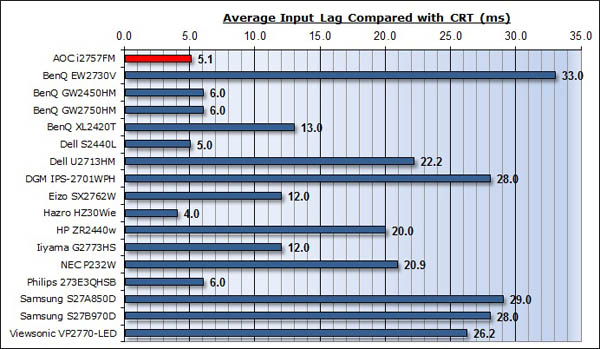
For the full reviews of the models compared here and the dates they were written
(and when screens were approximately released to the market), please see our
full
reviews index.
Our tests here are based on the new format using
SMTT 2.0. We have provided a comparison above against other models we have
tested to give an indication between screens. We have only included screens
which were tested using this new method to allow for a fair and realistic
comparison, and have removed any models tested using the old method.
The AOC i2757Fm shows a very low level of input
lag. This was measured at 5.1ms average. Note that this
is the overall display lag, and so accounts for the signal processing time + an
element of the pixel response time. The lag of this screen has been categorised
as CLASS 1 as detailed above. It should be perfectly fine for gaming as a
result, even for fast paced FPS.

Movies and Video

The following summarises the screens performance
in video applications:
-
27"
screen size makes it a pretty good option for an all-in-one multimedia screen
and comparable to smaller LCD TV's in size.
-
16:9
aspect ratio is more well suited to videos than a 16:10 format screen, leaving
smaller borders on DVD's and wide screen content.
-
1920 x
1080 resolution can support full 1080 HD resolution content
-
Digital HDMI interfaces support HDCP for any encrypted
and protected content
-
There
are no additional DVI or DisplayPort connectivity options available, only 2x
HDMI and 1x VGA. Might have been useful to see DisplayPort which is
increasingly popular for external Blu-ray devices and for AMD graphics cards.
-
Wide brightness range adjustment possible from the display, including a good
maximum luminance of ~250
cd/m2 and good minimum luminance of ~55 cd/m2. Should afford you very good control for different
lighting conditions.
-
Black
depth and contrast ratio are excellent for an IPS panel. Shadow detail in
darker scenes should not be lost.
-
Dynamic contrast ratio works to a small degree, offering a DCR of ~2043:1 in
practice. Might be useful to some users if you like this feature. At least it
works a bit unlike some screens.
-
'Movie' ECO mode preset available which simply locks the brightness control at
80%. Might be useful if you want to switch to a higher brightness than your
normal setup quickly, and without fiddling around with your 'standard' mode.
-
ClearVision feature accentuates the image sharpness, which might be useful in
some cases. It is controllable with 3 different levels of intensity. Worth
playing around with to see if you like it.
-
Very
good pixel responsiveness which should be able to handle fast moving scenes in
movies without issue. No real issue with overshoot as long as you stick to the
medium overdrive setting.
-
Slightly limited hardware level aspect ratio control options which may be
needed when connecting external devices, DVD players etc. Options for 'wide'
(16:9) and '4:3' only. A 1:1 pixel mapping mode or an 'auto' aspect ratio
retention might have been useful here as well.
-
Wide
viewing angles thanks to the IPS panel technology meaning several people could
view the screen at once comfortable and from a whole host of different angles.
-
Limited
range of ergonomic adjustments available from the stand with only tilt
available. Might be difficult to obtain a comfortable position for multiple
users or if you want to sit further away from the screen for movie viewing.
-
No
significantly noticeable backlight leakage, and none from the edges which is
good. This type of leakage may prove an issue when watching movies where black
borders are present but it is not a problem here.
-
Integrated speakers
available on this model along with an audio input connection as well. May be
ok for some occasional YouTube videos etc but probably not for watching many
movies. The headphone socket may also be useful to some users.
-
Make
sure you
adjust your graphics card settings if using HDMI from an NVIDIA card to
get the full range and proper contrast ratio.
-
Picture in picture (PiP) or Picture By Picture (PbP) are not available on this
model.
-
For
PAL sources, we have tested the screen and confirmed it will support
the full native resolution of 1920 x 1080 at 50Hz refresh rate.

Conclusion
The AOC was a pleasing debut for the new 27" 1920
x 1080 IPS generation we felt. The performance of the panel was very good
overall as you might hope for from modern IPS technology. Out of the box
performance was largely very good, although the colour temperature was a little
cool. With a good gamma curve, reliable sRGB colour space coverage and decent
colour accuracy the default setup was pleasing for what is really a low cost
screen. The black depth and contrast ratio were also excellent for an IPS panel,
including after calibration. In other areas the IPS technology offered the usual
wide viewing angles and also performed very well in terms of pixel response
times. With these fast pixel transitions and a nice low input lag, the screen
should be able to handle plenty of gaming and multimedia needs.
The design of the screen was interesting. On the
one hand the flat front, brushed aluminium style plastic finish and touch sensitive buttons gave it a
premium feel. The ability to remove the stand and use the screen on its own was
also an interesting option. We couldn't help feel though that the limited stand
adjustments, including quite a narrow tilt range, left the screen a little
inflexible. Connectivity options were also a little limited. Great to see 2x
HDMI here and the inclusion of MHL is a nice extra too. However, we were missing
a normal DVI, DisplayPort and USB connections. I suppose really these stand and
connectivity limitations are the trade-off for a lower cost screen at the end of
the day.
Users will of course be aware of the "low" 1920 x
1080 resolution on this model. To be fair, that is the same as modern TN Film
and AMVA panels offer in this size sector, it's just that perhaps we've been a
little spoilt with the super high resolution 2560 x 1440 IPS models in this
sector. To some users, the smaller resolution will be preferred anyway, where
graphics cards are more suited to the lower res and where the screen might be
used for movies and external devices more often, which don't need the extra high
resolution. Of course again, the lower resolution helps to keep the retail cost
down considerably.
The AOC i2757Fm retails in the UK for ~£240 GBP at
the time of writing, making it considerably less expensive than popular 2560 res
models like the Dell U2713HM (£570) of course. It's also quite a lot less than
the lower cost 27" 2560 res IPS models around like the Hazro HZ27WC (£400) and
DGM IPS-2701WPH (£360). Perhaps that's not really a fair comparison given the
differences, but the AOC is also priced competitively against some other new
1920 res IPS models like the Dell S2740L (£300 - review coming soon!) and also
the AMVA based BenQ GW2750HM (£200). If you are looking for a lower res panel
but want something large and with IPS technology then this is well worth a look.
|
Pros |
Cons |
|
Good default setup and very
good contrast ratio |
Limited stand adjustments,
with even the tilt range being narrow |
|
Fast pixel response times and
low input lag for gaming |
Quite limited connectivity
options |
|
Competitively priced for a
larger 27" IPS panel |
PWM used for backlight dimming |
|
 |
If you have enjoyed
this review and found it useful, please consider making a
small
donation to the site. |
|